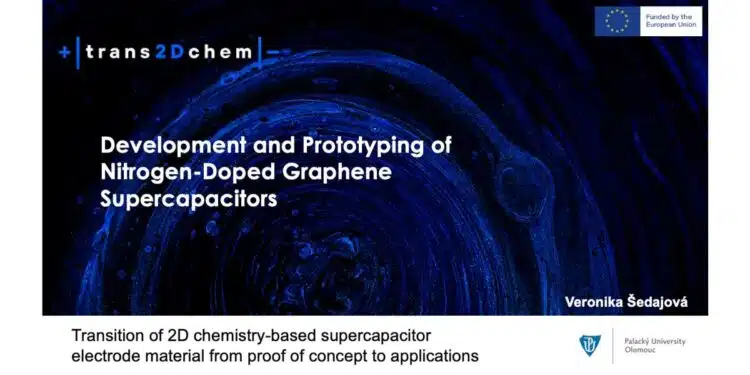The paper “Development and Prototyping of Nitrogen-Doped Graphene Supercapacitors ” was presented by Veronika Šedajová, Regional Centre of Advanced Technologies and Materials, Czech Advanced Technology and Research Institute (CATRIN), Palacký University Olomouc, Czech Republic at the 5th PCNS Passive Components Networking Symposium 9-12th September 2025, Seville, Spain as paper No. 4.4.
Introduction
The growing demand for reliable, fast, and sustainable energy storage solutions is driven by the rise of electromobility, renewable energy systems, and portable electronics. Traditional lithium-ion batteries dominate high-energy applications but suffer from slow charging, finite cycle life, and thermal limitations.
Supercapacitors, offering rapid charge/discharge cycles, long lifespan, and high power density, are emerging as a critical complement to batteries. Integration of advanced nanomaterials, particularly nitrogen-doped graphene, shows promise for bridging the performance gap between conventional capacitors and batteries.
Key Points
- Material Innovation: SC-GN3, a nitrogen-doped graphene derived from fluorographene, achieves a record bulk density of 2.8 g/cm³ with 16 at.% nitrogen incorporation.
- Exceptional Performance: Laboratory cells delivered ~200 Wh/L at 2.6 kW/L and >140 Wh/L at 52 kW/L with full capacitance retention over 10,000 cycles.
- Sustainability: SC-GN3’s metal-free composition (C and N only) supports scalable, environmentally friendly manufacturing.
- Slurry Optimization: Various conductive additives and binder concentrations were tested; a 10 wt.% binder formulation with Timcal additive was chosen for structural stability.
- Prototyping: Cylindrical wound-cell prototypes (70 cm and 140 cm electrodes) validated scalability and maintained volumetric energy density.
Extended Summary
This study focuses on the development and prototyping of SC-GN3, a novel nitrogen-doped graphene material designed to meet the growing need for high-performance supercapacitors. Traditional carbon-based electrodes achieve energy densities of 10–90 Wh/kg but are limited by low bulk density and volumetric energy storage. SC-GN3 addresses these challenges through a fluorographene-based synthesis that yields a layered, high-density graphene structure with tailored nitrogen functionalities (pyridinic, pyrrolic, and graphitic sites).
The material demonstrates outstanding electrochemical performance. Symmetric supercapacitor cells incorporating SC-GN3 achieved nearly 200 Wh/L at moderate power outputs and retained over 140 Wh/L at ultra-high power densities of 52 kW/L. Additionally, SC-GN3 exhibited excellent cycling stability, maintaining 100% capacitance after 10,000 high-current cycles, suggesting long-term durability.
To translate this laboratory innovation into practical devices, the research team developed scalable fabrication processes for both pouch and cylindrical formats under the EIC Transition Grant TRANS2DCHEM. Key process steps included optimizing slurry formulations with conductive additives and fluorinated binders to achieve uniform, durable electrodes. Experimental results indicated that a binder content of 10 wt.% provides the best balance between adhesion, cohesion, and electrochemical performance. Using these optimized slurries, over 120 long electrodes (70 cm) were fabricated for pilot-scale studies.
Prototyping involved assembling wound-cell supercapacitors with ionic liquid electrolytes (EMIM-BF4) in humidity-free environments. Electrodes were vacuum-impregnated to ensure complete electrolyte saturation. Testing of both 70 cm and 140 cm electrode prototypes demonstrated scalable performance. While total capacitance increased with electrode length due to greater active material mass, the volumetric energy density remained consistent, confirming effective material utilization and impregnation protocols.
By integrating material design, slurry optimization, and pilot-level prototyping, the study establishes a clear pathway for translating SC-GN3 technology into industrially viable supercapacitors. Its combination of high volumetric energy density, rapid power delivery, long cycle life, and sustainable composition positions SC-GN3 as a promising candidate for applications in electric vehicles, IoT devices, and grid support.
Conclusion
The development and successful prototyping of SC-GN3 mark a significant advancement in supercapacitor technology. This nitrogen-doped graphene offers a rare balance of high energy and power density, exceptional cycling stability, and sustainability due to its metal-free composition. Pilot-scale fabrication of cylindrical wound cells demonstrated that laboratory-level innovation can be translated into industrially relevant prototypes. Future work will focus on increasing mass loading, fine-tuning electrode formulations, and enhancing device assembly to further improve performance. SC-GN3-based supercapacitors have the potential to complement or surpass certain battery applications, paving the way for next-generation, high-efficiency energy storage solutions.






























